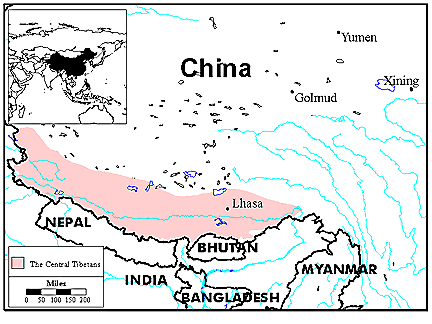|
|
Prayer Profile
The Central Tibetan of China
![[IMAGE]](../images/0052.jpg) The Central Tibetans live on the Tibetan Plateau of northern China. This region, which covers about 850,000 square miles, is surrounded by the world's highest mountains. It is known as "the roof of the world" because its average height is 14,000 feet.
The Central Tibetans live on the Tibetan Plateau of northern China. This region, which covers about 850,000 square miles, is surrounded by the world's highest mountains. It is known as "the roof of the world" because its average height is 14,000 feet.
Since 200 BC, the Tibetans have lived in a society closed to the rest of the world. The treacherous Himalayan Mountains have made travel almost impossible. In recent years, however, the doors have opened to allow the rest of the world a glimpse of this hidden culture.
Tibetans are a people of one race, culture, language, religion, and lifestyle. They are primarily farmers and nomadic herdsmen, with only a small number living in cities. Lhasa, Tibet's capital, is located in the Indus Valley and is the center for most of their farming.
What are their lives like?
Most of the people living in Tibet share a common origin, language, and religion. Family life is also a strong cord within the Tibetan culture. Marriages are usually monogamous, although polygamy and polyandry (multiple wives or husbands) have also been practiced.
Most Tibetans live as nomadic herders of yak, goats, and sheep. These families live in communes and continually move from pasture to pasture, living in yak-skin tents. Those who live in or near cities usually have two-story stone houses, the bottom floor being occupied by their livestock. City-dwellers practice ancient crafts, producing paper, fiber and wool weaving, metalwork, and woodcarvings. A growing number of Tibetans now live in state communes located in the mountains, where forestry is their chief resource.
Tibetans are extremely superstitious people. They believe, for example, that a newlywed couple will experience misfortune if snow falls during their wedding ceremony, or if an owl is seen perching on their rooftop. Conversely, they believe that good luck is in store for anyone who sees a source of running water or encounters a funeral procession.
Traditional Tibetan dress includes long robes for both men and women, and ornate jewelry. They have a simple diet of barley products, mutton, dairy items, root crops, tea, and beer.
What are their beliefs?
Buddhism is the national religion in Tibet; however, their Buddhist practices are intermingled with the 2200 year old religion, Bon. Bon is a mixture of the occult, black magic, and reincarnation. It holds a belief in gods, demons, and ancestral spirits. Buddhism teaches that right thinking, ritual sacrifices, and self-denial enable the soul to reach nirvana (a state of eternal bliss) at death. They live in fear of their gods and constantly strive to appease them with religious chants, rituals, and sacrifices. Also, each Tibetan carries a dharma (prayer wheel) that is constantly twirled in hopes of keeping evil spirits away. These Buddhists look to the Dalai Lama as their supreme spiritual authority, even though he was deposed from China in 1951.
What are their needs?
Throughout history the Tibetans have been overthrown by the Mongols, the Manchu, and the Han Chinese. In 1951, the Chinese invaded and occupied Tibet. Since that time more than a million Tibetans have been brutally killed. Many of them have fled to India, Nepal, and Bhutan as refugees. They are a people in need of true and lasting peace.
The quality of health care, housing, utilities, and education among the Tibetans is poor. Only about 30% of their population can read. The nomadic lifestyle of the Tibetans will make it very difficult for missionaries to reach them. Transportation in Tibet is also challenging. Under Chinese rule, Christianity is strictly forbidden; however, Tibetans are open to the beliefs of outsiders. One organization has reported that there are a small number of Tibetan Christian refugees in India.
Prayer Points
- Pray against the spirit of Buddhism that has kept the Tibetans bound.
- Ask God to soften the hearts of China's governmental leaders towards the Gospel.
- Pray that the doors of China will soon open to missionaries.
- Ask the Lord to call people who are willing to go to China and share Christ with the Tibetans.
- Pray that God will strengthen, encourage, and protect the small number of believers who live among the Central Tibetans of China.
- Ask God to create a hunger within the hearts of the Tibetan people to know Jesus Christ.
- Pray that Tibetan refugees will find Christ and then return to their homeland and share the Gospel with their own people.
- Ask God to raise up a strong local church among the Central Tibetans.

Statistics
Latest estimates from the World Evangelization Research Center.
THE PEOPLE
- People name: Central Tibetan
- Country: China
- Their language: Zang Wen
- Population:
- Largest religion:
- Christian: 1.4%
- Church members: 68,063
- Scriptures in their own language: Bible
- Jesus Film in their own language: None
- Christian broadcasts in their own language: Available
- Mission agencies working among this people: 15
- Persons who have heard the Gospel: 2,012,700 (42%)
- Persons who have never heard the Gospel: 2,848,900 (58%)
THEIR COUNTRY
- Country: China
- Population:
- Major peoples in size order:
- Major religions:
- Number of denominations: 42
© Copyright 1997
Bethany World Prayer Center
This profile may be copied and distributed without obtaining permission
as long as it is not altered, bound, published
or used for profit purposes.
![[HOME BUTTON]](../graphics/home.jpg)
![[CALENDAR BUTTON]](../graphics/calico.jpg)
![[LIST BUTTON]](../graphics/listico.jpg)
[Home]
[Calendar]
[Country List]
|